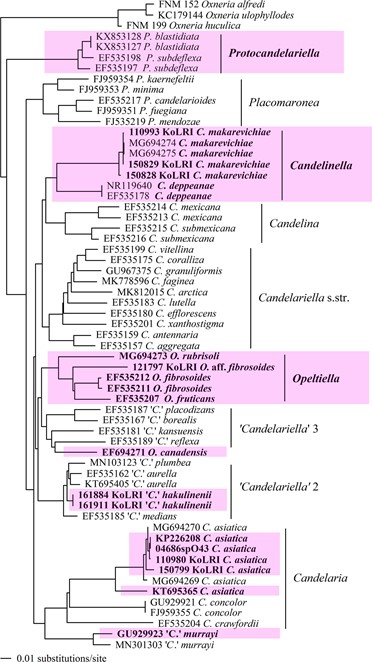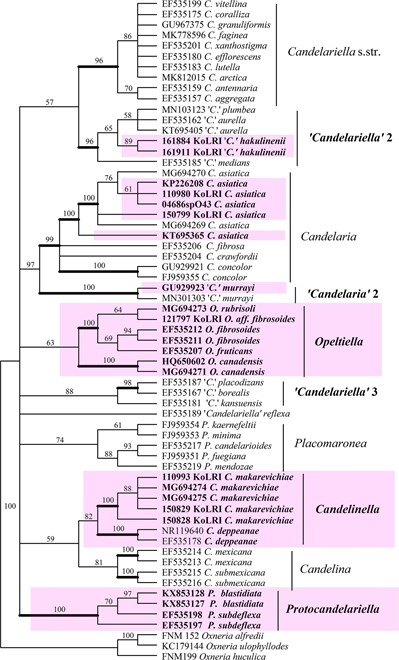Protocandelariella Poelt, D. Liu, J.-S. Hur et S. Y. Kondr., gen. nov.
MycoBank number: MB 836764; Index Fungorum number: MB 836764; Facesoffungi number: FoF
Similar to the genus Candelariella, but differs in having squamulose thallus and in having conidia from conidiogenous cells on the lower surface.
Type species: Protocandelariella subdeflexa (Nyl.) Poelt, D. Liu, J.-S. Hur et S. Y. Kondr.
Thallus squamulose, sometimes poorly developed and then granular to indistinct, pale grey to pale brownish grey, somewhat shiny, cortical layer consisting of two layers, i.e. the upper dead compressed hyphae (or without), lower part paraplectenchymatous, without or with blastidia on margins and / or the lower side of squamules. Apothecia biatorine, usually abundant, disc pale yellow to yellow, some- what convex to very convex, yellow; asci 8-spored, ascospores hyaline, simple to 1-septate, narrowly ellipsoid to ovoid. Conidiomata usually lacking, instead the lower surface of the squamules are covered by conidiophores, conidia hyaline, more or less globose.
Chemistry: calycin, pulvinic acid, pulvinic dilactone and vulpinic acid. Apothecial disc K+ reddish, KC–, C–.
Etymology: It is named after its similarity to the genus Candelariella.
Distribution and ecology: So far two species belong to this genus, which are hitherto known from North America, southern and central Europe, North Africa, Asia and New Zealand. They grow mostly on the bark of broad-leaved trees, sometimes on wood.
Taxonomic notes: The genus Protocandelariella is similar to the genus Candelariella, but differs in having squamulose thallus and in having conidia from conidiogenous cells on the lower surface (vs. conidia produced by the pycnidia on the upper surface).
Protocandelariella species produce conidia from conidiogenous cells on the lower surface of thalline squamules and differ from the other species of the genus Candelariella as well as other genera of the Candelariaceae producing conidia by the pycnidia on the upper surface. Results of our nrITS phylogeny confirm previous data (Liu et al. 2019, Westberg et al. 2007, Yakovchenko et al. 2017) that only the Protocandelariella (and sometimes the Placomaronea branch as well) is positioned in the outermost position to all members of the Candelariaceae (Fig. 1). The Protocandelariella is positioned as a separate robust monophyletic branch based also on multigene phylogeny (Fig. 2).
Poelt (1974) recognised ‘Candelariella’ subdeflexa as a unique species among the representatives of the genus Candelariella. Poelt’s name as a ‘pro- tocandelariella’ in the family Candelariaceae is here used for the new genus, which has confirmation from morphological as well as from molecular points of view. The Protocandelariella includes P. subdeflexa, the type species, and recently described ‘Candelariella’ blastidiata Yakovchenko. Morphological and molecular phylogenetic data support the close relationship of P. subdeflexa and P. blastidiata representing a so-called ‘species pair’ (Poelt 1970), where P. sub- deflexa reproduces by sexual propagules and P. blastidiata mostly by vegetative ones. Both species also possess asexual conidia as additional propagules; however, the production of conidia appears to be less effective in P. blastidiata.

Fig. 1. Position of Candelinella, Opeltiella and Protocandelariella species in the phylogenetic tree of the Candelariaceae based on nrITS phylogeny

Fig. 2. Position of Candelinella, Opeltiella and Protocandelariella species in the phylogenetic tree of the Candelariaceae based on combined multigene phylogeny
Species
